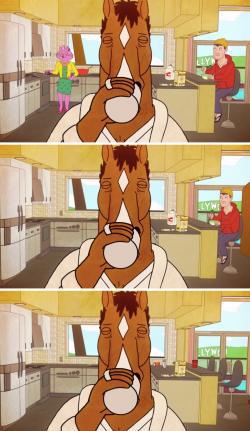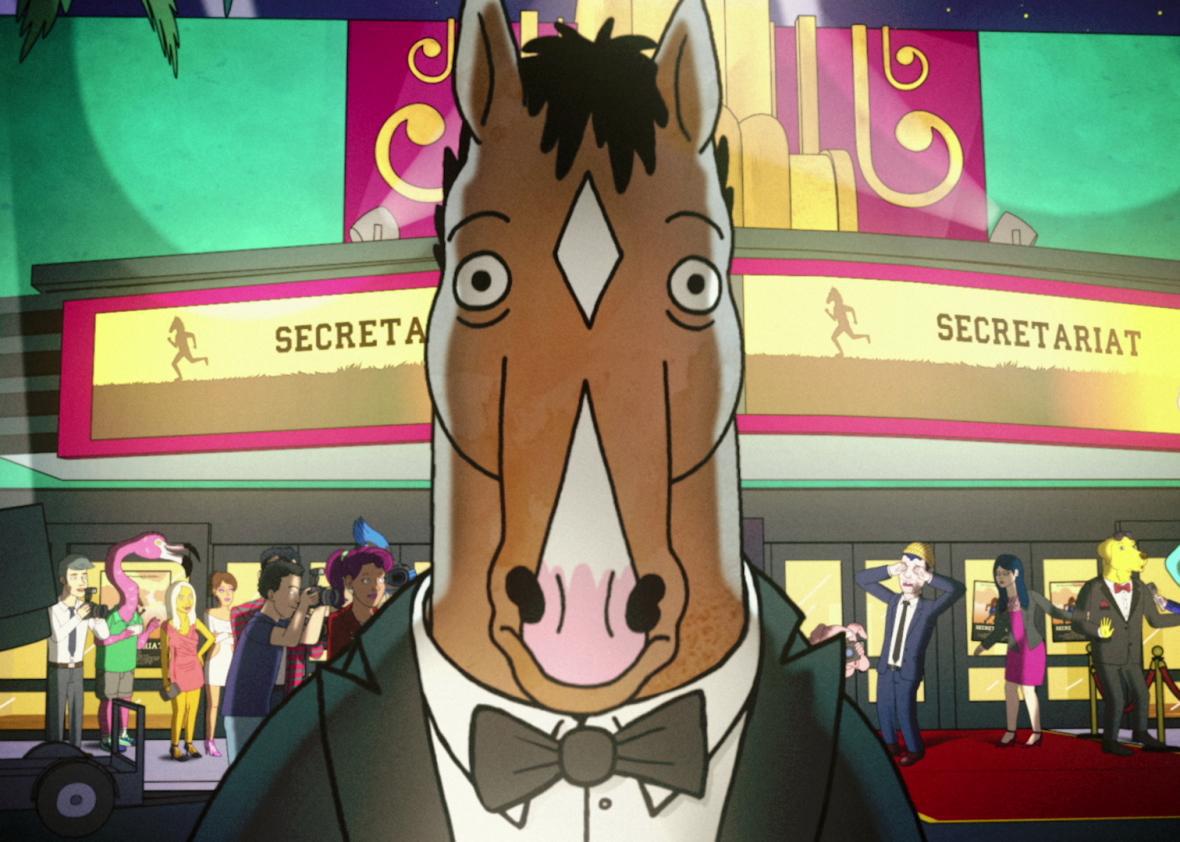The article contains spoilers for Season 4 of BoJack Horseman.
Earlier this year, Netflix introduced a new, game-changing feature to its service: a “Skip Intro” button that allows you to instantly zip past the opening credits of many of its television shows and even some movies. This is an incredibly useful feature if you’ve been binge-watching Friends and don’t want to hear the Rembrandts sing about how they’ll be there for you for the sixth time in a row. But there are also occasions when you should resist clicking that little rectangle at the corner of the screen, because there are some shows with title sequences that you just shouldn’t skip.
Netflix’s BoJack Horseman, which debuted its fourth season on Friday, is one of those shows, and it’s not just Patrick Carney’s jazzy theme song that makes its title sequence so great. See, since the very first season of BoJack, the opening titles have always followed a certain pattern: BoJack wakes up in bed and then drifts through an average day, remaining stationary and drinking while the background moves behind him (a pretty fitting visual for how BoJack goes through life without taking any real responsibility for his actions). He starts by floating through the rooms of his own house, passing through his bedroom, living room, and kitchen, before the background gives way to—depending on the season—either a supermarket where he’s hounded by paparazzi, a film set, a red carpet, or a kaleidoscope of the show’s supporting characters. Finally, he arrives back home, now wearing an increasingly rumpled tuxedo, whizzing past a house full of partygoers before plummeting backward into his pool. Here’s what the opening credits looked like in Season 1:
For most of BoJack Horseman’s first three seasons, the first part of this title sequence, the part set in BoJack’s home, has remained exactly the same from episode to episode. In BoJack’s living room and kitchen, we see three crucial characters going about their business behind him: Diane knocks at the back door, Todd wakes up on the couch and walks over to the kitchen, and Princess Carolyn makes pancakes while gabbing on her cell. Not coincidentally, these are also the three most important people (and animals) in BoJack’s life: Diane, his biographer, understands him better than anyone; Todd distracts BoJack so that he doesn’t have to be alone with his thoughts; and Princess Carolyn, BoJack’s agent and on-again-off-again love interest, has been the one real constant throughout his career.

Netflix
In the last few episodes of Season 3, however, these three people start to vanish, gradually, from the title sequence. As Todd’s startup becomes more successful, the living room behind BoJack is suddenly crowded with Abracadabra employees—making it easy to miss the fact that Diane is no longer knocking at the back door. A couple of episodes later, after BoJack fires Princess Carolyn, she disappears from the background, too. By the season’s penultimate episode, as BoJack continues to spiral, there’s nobody there, and he just drifts through an eerily empty house. Especially if you’ve been binge-watching, this comes as something of a gut punch, a sign that BoJack’s self-destructive behavior has finally driven away every single person in his life who cares about him. He’s completely alone.
That’s where Season 4 picks up, and the background of the title sequence continues to reflect what a disaster BoJack’s life has become, complete with a broken window and bottles and cups scattered all over the floor. But then, over the course of the season, BoJack does find something to fill his life, through no effort of his own: family. In “Commence Fracking,” the background of the opening titles changes once again so that Hollyhock, BoJack’s long-lost “daughter,” can be seen, first on the couch reading a magazine, then eating an apple, almost as a replacement for Todd. Then, when BoJack’s mother and her nurse move in in “Stupid Piece of S–t,” they join the background too, with Beatrice even pouring coffee for Hollyhock in the kitchen (an ominous bit of foreshadowing). Not only that, but the window is fixed, the floor is clean, and there are now boxes of Beatrice’s stuff on the ground, photos on display, and Hollyhock’s stuffed carrot on the couch. Not only is the house full of life again, for the first time ever, it looks … home-y.

Netflix
Of course, BoJack Horseman has never been as optimistic as its show-within-a-show, Horsin’ Around, and BoJack’s newfound domesticity doesn’t last. What happens on the show is mirrored in the opening credits: First Hollyhock leaves, then Beatrice and her nurse, leaving BoJack alone once again, but with little reminders of family, like the photos and the carrot, lingering in the background. It’s a devastating image.
Yes, these few seconds in the opening credits are a very minor detail in the grand scheme of things, but BoJack Horseman is a show that specializes in minor details and rewards the people who notice them. In this case, that reward is an entire emotional arc hidden in a part of the show that most viewers take for granted. The least we can do is spend those few seconds appreciating it.
